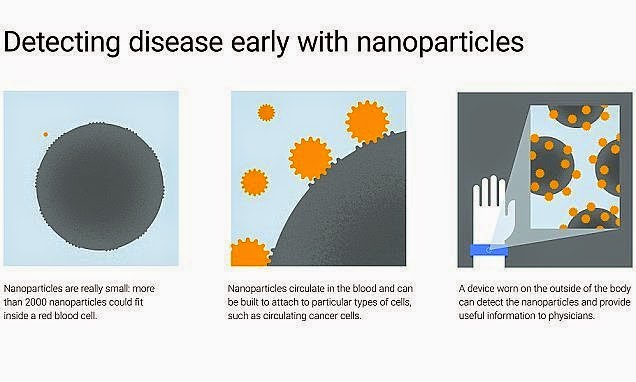Love or hate Google, you cant deny their ability to dream. Their Google X research lab has taken on the “C” word – Cancer. It has spent a lot of money and gathered top talent from all over the world to do one thing – detect cancer early. In a way only Google can, in the form of a pill. Before you get too excited, it is in very preliminary stages.
I just get blown away when technology meets the world. It doesn’t solve for everything but it adds a new perspective on the world that can solve questions. Heres to the dreamers! If I may,I’ going to use a Steve Jobs quote for Googlers everywhere.
“Here’s to the crazy ones, the misfits, the rebels, the troublemakers, the round pegs in the square holes… the ones who see things differently — they’re not fond of rules… You can quote them, disagree with them, glorify or vilify them, but the only thing you can’t do is ignore them because they change things… they push the human race forward, and while some may see them as the crazy ones, we see genius, because the ones who are crazy enough to think that they can change the world, are the ones who do.”
– Steve Jobs
Below is an article written by Cade Metz of Wired online, explaining the science behind a cancer-detecting pill.
Basically, Gambhir says, they wanted recommendations on what moonshots they should try for. And as Google built up its health operations, he continued to consult with the company and the health sciences lab it now runs in Silicon Valley.
One of the projects Google eventually settled on was what Conrad calls the “Nanoparticle Platform,” an effort to build a cancer-detecting pill, publicly revealed last week. The idea is that this pill will contain magnetic nanoparticles that can latch onto certain cancer-related molecules in the bloodstream—and that a wearable device could then use magnetic properties to recognize when this happens. As Gambhir points out, this is just one of many efforts to detect cancer in vivo—i.e. within the body, without drawing blood. But he’ll also tell you that Google brings something new to such a project.
Part of it, he explains, is that Google has built an unusually talented team that spans multiple disciplines, including physics, chemistry, and biology. “They have brought on a lot of very smart people that are thinking about these problems in very unique ways, ” Gambhir says, pointing out the company has hired some researchers from his lab. Certainly, some academic centers have built their own multi-discipline teams, but on top of this, Google provides a new kind of corporate leverage. It aims to push this sort of thing into the market at speed.
“Academic institutions aren’t as good at making an actual product. Research has to leave the academic world and move into the industrial world, and most industrial world applications are focused on therapeutics rather than diagnostics—and certainly not diagnostics based on wearable sensors,” Gambhir says.
Conrad and his team have taken much the same approach in building a contact lens that can detect blood sugar levels through the tears in your eyes. The lens would let diabetics track their blood sugar without ever having to draw their own blood, and through various third parties, Google is now working to turn the thing into a product. The lens was originally developed at Microsoft, but it’s Google that’s trying to commercialize the thing.
All that said, it will likely be years before a Google cancer-detecting pill reaches the market—if it reaches the market at all. Google has yet to test its nanoparticles on humans—at this point, it’s sending prototypes into artificial human limbs—and according to Muneesh Tewari, who heads a research lab working on early detection of cancer at the University of Michigan, reaching the market will require not only additional research but some rather significant regulatory wrangling. “The concept is very exciting and has merit—to do more proactive and continuous monitoring in the blood,” he says. “The question is how feasible is this and over what time frame. It’s still quite early days.”
First, he says, Google must demonstrate that its particles can indeed attach to markers in the bloodstream that are highly specific for cancer—and that a wearable device can read information from these particles well enough to make an accurate diagnosis. And then it must win approval from the Food and Drug Administration. Google has said that its particles are similar to those used with MRIs and other clinical procedures, but according to Tewari, the regulatory safety bar may be higher because its pill is intended to be used by healthy individuals
Colin Connolly—a senior scientist with Quantum Diamond Technologies, a company that specializes in biological sensors built with magnetic nanoparticles—says much the same. “It remains to be validated that this would be a safe way to go. With anything that’s inside a person—as opposed to a blood draw—the challenge is greater.”
Indeed, it is. But that’s largely the point. The Google X lab was built for challenges like this. Says MIT’s Robert Langer, another academic who has consulted with the company on its nanoparticles project: “A lot of companies are doing one step in a project like this. They’re doing four steps.”


